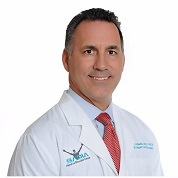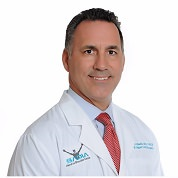
Dr. Alejandro Badia
If young athletes sustain a “jammed finger” on the athletic field, do NOT, above all, fall into the time honored trap (or urban legend) of “pull my finger” with your coach or teammate. This may worsen the soft tissue injury sustained.
MIAMI (PRWEB)
October 07, 2020
Experts call the finger’s middle joint “unforgiving” when injured. That’s why a digit jammed by a hard-thrown ball or smashed in a car door may be more than a “no-big-deal,” says hand and upper limb orthopedic surgeon and author of Healthcare from the Trenches, Dr. Alejandro Badia. Dr. Badia notes that this middle joint – the proximal interphalangeal joint or PIP – is what usually absorbs much of the impact from a blow and is most susceptible to trauma. Dr. Badia adds that ““jammed finger” is a terrible and nonspecific misnomer. Using that term only describes the perceived mechanism of the injury, not at all the actual diagnosis like a fracture, dislocation or ligament or tendon injury. Oftentimes, it’s difficult to determine immediately whether the finger’s collateral ligaments have been simply overstretched or sprained by the injury or whether the joint has been dislocated or even fractured,” Dr. Badia says. The collateral ligaments are located on either side of the PIP and help support it.
Dr. Badia warns that delays in diagnosis and treatment by an orthopedic specialist can lead to complications, such as fibrosis and stiffness, reduction in the finger’s range of motion, degenerative arthritis of the joint, and finger-joint deformities, which may be difficult to later repair and can interfere with a person’s grasping abilities.
In fact, scientists indicate the PIP provides as much as 85 percent of the motion required for gripping.
“Time is of the essence in seeking treatment,” says Dr. Badia, an expert in care of the hand, wrist, and other upper limb joints and founder and chief medical officer of the Florida-based Badia Hand to Shoulder Center and OrthoNOW®. “Too many times, patients consider a finger injury as minor and avoid contacting a physician until days – even weeks afterwards – when pain and swelling persist in the joint, and the finger becomes increasingly stiff.”
This is particularly true of athletes – or their trainers — who delay care or seek inappropriate treatments that can result in irreversible loss of motion and finger abnormalities, like swan neck deformity in which the finger becomes bent towards the palm of the hand, say authors of a report published in a 2018 issue of the journal Hand Clinics.
With the exception of the thumb, each finger comprises an intricate network of three bones (phalanxes), three joints, and supporting tissue, ligaments, blood vessels and nerves. “Diagnosing and treating injuries anywhere along this system can be difficult enough even for the experienced orthopedic specialist,” Dr. Badia says. “That’s why seeking treatment for a finger injury from hospital emergency physicians or family doctors unfamiliar with the complexities of the hand is not a recommended route of care.”
The PIP is a “hinge joint” that allows the finger to flex and extend. It is located between the knuckle (the metacarpophalangeal joint) and the distal joint at the fingertip. A blow or smash directly on the finger or stress unexpectedly placed on an extended finger can cause a wide diversity of PIP-related injuries.
A “sprained finger, for example, usually means one or both of the PIP’s collateral ligaments have been stretched or partially torn because of some force that bent the finger too far sideways. Such sprains can be managed using “buddy taping,” in which the traumatized finger is taped with an adjoining healthy finger. “Buddy taping requires the patient to bend the injured finger when using the healthy one,” Dr. Badia explains. “Exercise of the injured finger early in recovery is important because the PIP joint can quickly become stiff when immobilized.”
A complete tear of one of the collateral ligaments may also be associated with a PIP dislocation or fracture, Dr. Badia explains.
When the PIP is dislocated, the specialist attempts to maneuver bones back into position – a process called closed reduction. Dr. Badia emphasizes that “at no time should patients try to reduct a dislocation on their own. Doing so will likely result in only more damage to the joint.”
Should more conservative, non-surgical methods fail to resolve a PIP dislocation, then surgery – open reduction — may be necessary. Surgery also is likely needed if a PIP fracture has occurred, and the fracture is severe, complex, or unstable or if the PIP’s volar plate, the thick ligament that joins a finger’s lower bone to the middle bone on the palm side of the hand, has completely ruptured. “Volar plate damage can occur when a finger is bent too far backwards,” Dr. Badia says.
Both closed reduction and surgical repair are generally followed by splinting of the injured finger and early post-operative therapy to maintain the finger’s range of motion, Dr. Badia states.
Of course, the best recourse is simply to avoid finger and hand injuries, Dr. Badia says. He offers these tips:
- Learn tool safety and use the right tool for the right job.
- If the task calls for it, wear protective gloves.
- Keep fingers away from the moving parts of any equipment.
- Remove decorative rings when engaged in sports or other potentially hazardous activities.
- Consider strengthening finger grip as part of a routine exercise regimen.
- If a finger is injured, apply ice, keep the digit elevated above the heart and take over-the-counter anti-inflammatory medications to help reduce pain and swelling.
Dr. Badia adds that if young athletes sustain a “jammed finger” on the athletic field, “do NOT, above all, fall into the time honored trap (or urban legend) of “pull my finger” with your coach or teammate. This may worsen the soft tissue injury sustained.” “And remember, if symptoms persist for more than a few days, contact an orthopedic specialist for evaluation,” Dr. Badia says.
Bio: Alejandro Badia, MD, FACS, is an internationally renowned hand and upper-limb surgeon and founder of Badia Hand to Shoulder Center and OrthoNOW®, a network of walk-in orthopedic centers. Dr. Badia is the author of Healthcare from the Trenches. http://www.drbadia.com http://www.orthonowcare.com
Share article on social media or email:

